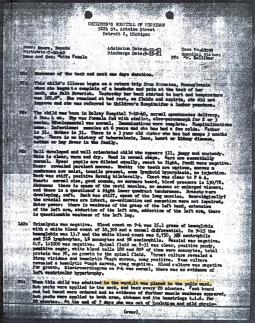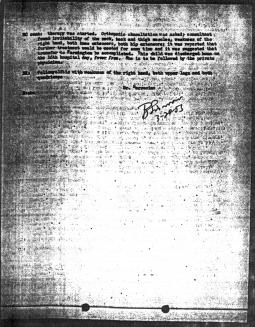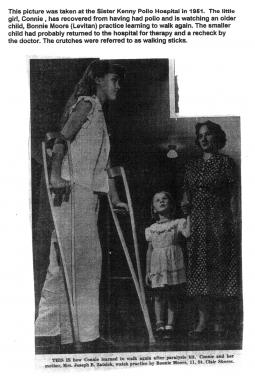Polio Place
A service of Post-Polio Health International
Artifacts
Admission Papers for Bonnie (Moore) Levitan
Bonnie E. Levitan; 1951; Children's Hospital of Michigan; Detroit, Michigan
It was August, 1951, and I had just turned 11. My pregnant mother, new stepfather, three year-old sister and I had just returned from a trip to Scranton, Pennsylvania. My mother noted that I had a fever, but assured me I would feel better in the morning. Climbing the stairs to the bedroom was exhausting and I discovered my aching muscles would not allow me to climb into the upper bunk.
Things were definitely not better in the morning! My parents took me to see the doctor. I remember the visit well. The doctor was a woman named Dr. Zolliker. In 1951, a woman doctor was almost unheard of, and additionally, she was a specialist - a pediatrician! In 1951, no one went to a pediatrician unless they were very sick or very rich, and I knew we were certainly not rich...far from it! During the exam, as my mother watched, dead silence enveloped the room. Finally, Dr. Zelliker spoke and told my mother it looked as if I was coming down with polio, and directed that I immediately be taken down to Children's Hospital for a lumbar puncture to confirm her diagnosis.
On the trip down there, I was beginning to slip in and out of consciousness due to the high fever, but I do remember arriving at Children's Hospital. The halls were crowded. Stretchers were in the hall with patients on them. I took my turn waiting on a stretcher for what seemed like an eternity. Finally, I was wheeled into a smaller examining room where I was transferred onto the exam table. I was then placed on my side and rolled into a tight ball and held in that position by some staff members. I was rolled so tightly that I had trouble breathing and it seemed to take a long time to get the needle into my spine and extract some fluid for testing. From a child's perspective, ten seconds in that position is too long!
The experience was definitely both painful and indelibly printed in my brain. I do not remember much after that as I slipped into a coma for about eight or ten days while the virus did its damage. I felt quite hazy as I began to regain full consciousness. I found myself in isolation and when the attending nurses did enter the room, they wore long white gowns covering their entire bodies, head coverings, gloves and masks. When they left, they had to remove their gowns and bag them. When the full extent of what happened to me became evident and all the assessments were finished, I was completely paralyzed from the neck down.
In my original admission papers from Children's Hospital, I was referred to as "it." One doctor wrote, "It should be sent to Farmington." Well, "it" did not go to Farmington, "it" went to Sister Elizabeth Kenny Rehabilitation Hospital in Pontiac. I went through a long sometimes painful rehabilitation for about six months. Upon discharge from the hospital, I used crutches that came up to my elbows with a piece of leather around the elbows. They were called walking sticks. But rehabilitation and recovery is a whole other story.




















































